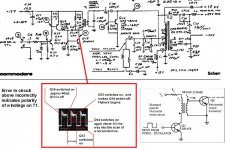Be aware of some aspects of the design of your video monitor.
The H drive pulses are not sync pulses. They are the actual drive signal that causes the the horizontal scan circuit, specifically the output transistor Q14, to switch on and off for the correct duration during a horizontal scanning line, and for this to generate both the correct scanning raster (array of scanning lines) width on the CRT face and the correct EHT (extra high tension) voltage for the final anode of the CRT and the correct +85v boost voltage and the correct -30V power rail.
This H drive pulse has to have the correct on-off duty cycle as shown on the schematic (and this is much wider than what an H sync pulse normally is at around 5uS wide). The output transistor Q 14 is often switched on for about 2/3 of the scanning line, perhaps around 40uS and switched off at the end of it, this generates the scanning current for the right hand side of the raster.The scanning current for the left hand side of the raster is derived from recovered magnetic energy of the H yoke coils and H output transformer and passed back to the power supply by the Damper diode CR17. That is why it is sometimes called an efficiency diode too.
Some monitors (not yours) have a separate horizontal oscillator in them and it looks after the tasks described above, and that oscillator gets synchronized with a typical 5uS wide H "sync" pulse. So if the sync pulse is not there, the H scanning and EHT generation is still working.
If your H drive pulse is stuck low or high or not there, due to the AC coupling by C16, then all the transistors Q11,Q12,Q13 will be turned off (not conducting) and there will be no drive pulses to the base of Q14, so no EHT, no 85 or -30V rails.
So the quickest way to determine if the H drive pulse is actually there, and normal, without a scope, is to simply test the 85 and -30V rail to see if they are there and at the correct voltage. If they are not, then you will need to check why, whether the H drive pulse is not there or perhaps there is still a fault in the circuitry of Q11,Q12,Q13, & Q14.
I would suggest making sure the video monitor is working normally before diving into the rest of the computer changing IC's etc. It would be best initially to put every original IC back in (make very sure not to fit any in reverse). Once the CRT monitor is working, or if it is definite that there is an issue with its H & V drive signals, or video signal, then move to fault find the computer board.


